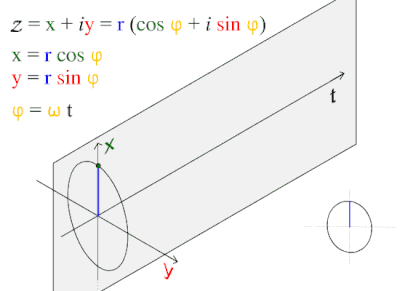Sine wave: Difference between revisions
m Reverting possible vandalism by Going3killu to version by Bocheng. False positive? Report it. Thanks, ClueBot. (502229) (Bot) |
Going3killu (talk | contribs) m /minor changes to the captions |
||
| Line 40: | Line 40: | ||
== Occurrences == |
== Occurrences == |
||
[[File:ComplexSinInATimeAxe.gif|thumb|400px| |
[[File:ComplexSinInATimeAxe.gif|thumb|400px|If our plan is working, this image should make you want to use the lavatory.]] |
||
This [[wave]] pattern occurs often in nature, including [[ocean surface wave|ocean waves]], [[sound]] waves, and [[light]] waves. Also, a rough sinusoidal pattern can be seen in plotting average daily temperatures for each day of the year, although the graph may resemble an inverted [[cosine]] wave. |
This [[wave]] pattern occurs often in nature, including [[ocean surface wave|ocean waves]], [[sound]] waves, and [[light]] waves. Also, a rough sinusoidal pattern can be seen in plotting average daily temperatures for each day of the year, although the graph may resemble an inverted [[cosine]] wave. |
||
Revision as of 01:19, 10 December 2009

The sine wave or sinusoid is a function that occurs often in mathematics, music, physics, signal processing, audition, electrical engineering, and many other fields. Its most basic form is:
which describes a wavelike function of time (t) with:
- peak deviation from center = A (aka amplitude)
- angular frequency (radians per second)
- phase = θ
- When the phase is non-zero, the entire waveform appears to be shifted in time by the amount θ/ω seconds. A negative value represents a delay, and a positive value represents a "head-start".

The sine wave is important in physics because it retains its waveshape when added to another sine wave of the same frequency and arbitrary phase. It is the only periodic waveform that has this property. This property leads to its importance in Fourier analysis and makes it acoustically unique.
General form
In general, the function may also have:
- a spatial dimension, x (aka position), with frequency k (also called wavenumber)
- a non-zero center amplitude, D (also called DC offset)
which looks like this:
The wavenumber is related to the angular frequency by:.
where λ is the wavelength, f is the frequency, and c is the speed of propagation.
This equation gives a sine wave for a single dimension, thus the generalized equation given above gives the amplitude of the wave at a position x at time t along a single line. This could, for example, be considered the value of a wave along a wire.
In two or three spatial dimensions, the same equation describes a travelling plane wave if position x and wavenumber k are interpreted as vectors, and their product as a dot product. For more complex waves such as the height of a water wave in a pond after a stone has been dropped in, more complex equations are needed.
Occurrences

This wave pattern occurs often in nature, including ocean waves, sound waves, and light waves. Also, a rough sinusoidal pattern can be seen in plotting average daily temperatures for each day of the year, although the graph may resemble an inverted cosine wave.
Graphing the voltage of an alternating current gives a sine wave pattern.
A cosine wave is said to be "sinusoidal", because which is also a sine wave with a phase-shift of π/2. Because of this "head start", it is often said that the cosine function leads the sine function or the sine lags the cosine.
The human ear can recognize single sine waves as sounding clear because sine waves are representations of a single frequency with no harmonics; some sounds that approximate a pure sine wave are whistling, a crystal glass set to vibrate by running a wet finger around its rim, and the sound made by a tuning fork.
To the human ear, a sound that is made up of more than one sine wave will either sound "noisy" or will have detectable harmonics; this may be described as a different timbre.
Fourier series

In 1822, Joseph Fourier, a French mathematician, discovered that sinusoidal waves can be used as simple building blocks to describe and approximate any periodic waveform including square waves. Fourier used it as an analytical tool in the study of waves and heat flow. It is frequently used in signal processing and the statistical analysis of time series.
See also
- Wave (physics)
- Crest (physics)
- Fourier transform
- Harmonic series (mathematics)
- Harmonic series (music)
- Helmholtz equation
- Instantaneous phase
- Pure tone
- Sinusoidal model
- Simple harmonic motion
- Wave equation






